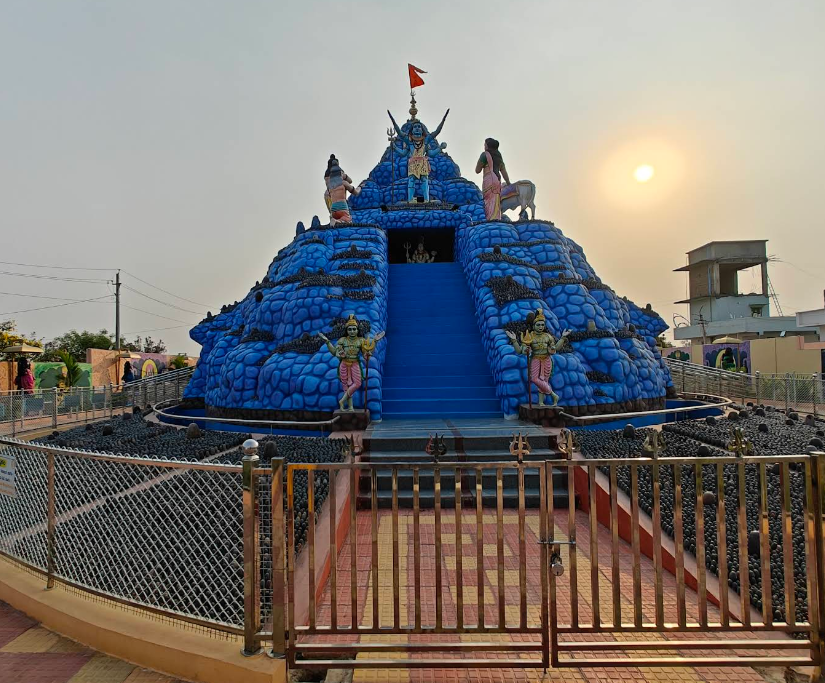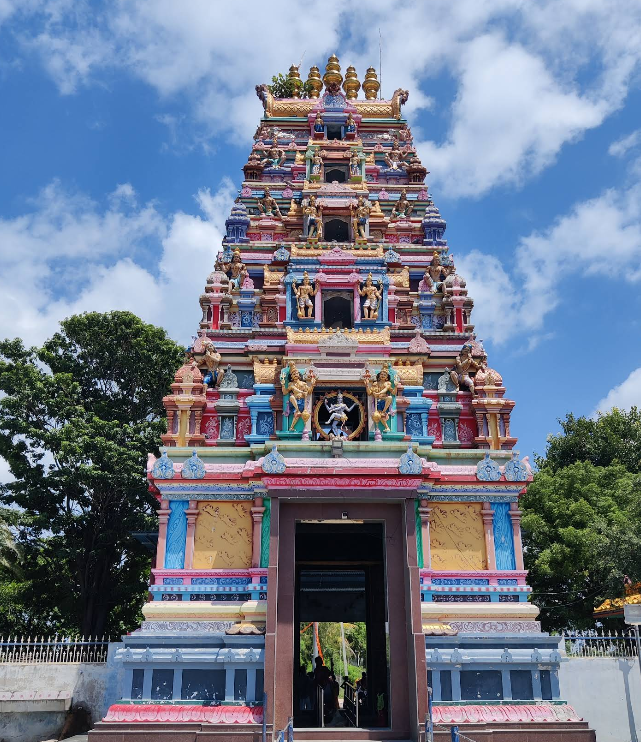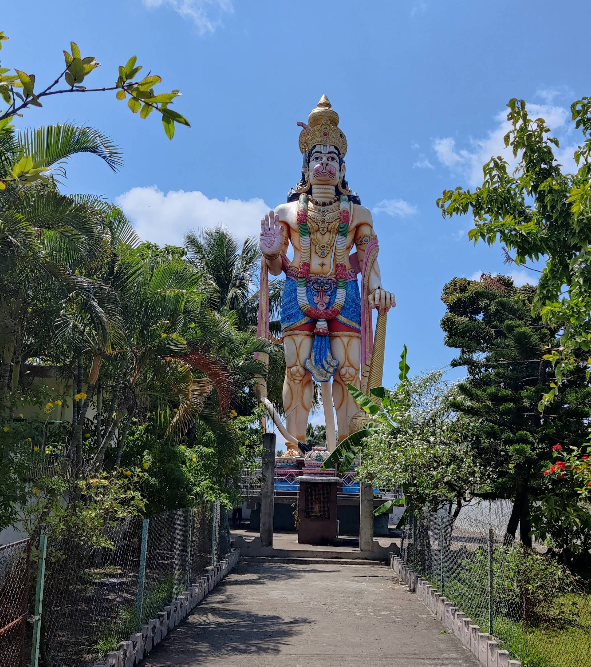Annapoorna Vishalakshi Sametha Vishveshwara Panchayathana Ksetram Gandhinagar
🖼️ Photo Gallery




🛕 Temple Info
Tucked away in a quiet rural setting, the temple feels like a peaceful haven amid paddy fields, a small water canal, and the soft hum of the countryside. It’s the largest temple in the locality, and its open grounds reflect a blend of nature’s calm and spiritual energy. The temple complex is beautifully conceived, with multiple deities welcoming visitors in various niches — not just Lord Shiva, but many others, all in one sacred space.
The main deity is Vishweshwar (a form of Lord Shiva), and a giant statue of Lord Hanuman stands tall and proud within the compound, drawing particular attention and reverence. There is a specially dedicated place for homa rituals (ಹೋಮಾ ಶಾಲೆ), showing that this temple supports deep Vedic traditions. The priests here are learned and carry out their duties with devotion and skill, making every ritual feel meaningful and sincere.
Though the gardens around the temple are laid out with thought, they are not always well maintained. Still, the natural beauty of the surroundings — from the green fields to the gently flowing canal — gives a very serene backdrop to one’s spiritual journey. The temple’s remote location adds to this feeling of quiet retreat, as though you’ve stepped away from the world to be closer to the divine.
💫 Importance
This temple holds great significance for the local community and for devotees who visit from farther afield. It’s a place that combines many strands of Hindu worship: you can offer your prayers here to Shiva (in the form of Vishweshwar) and also feel the protective strength of Lord Hanuman. The presence of so many deities in one temple makes it a spiritually rich spot — a place where families can come together and find different aspects of divinity all under one roof.
Devotees often remark that visiting the temple brings a strong sense of peace. The calmness of the rural environment, the careful rituals, and the stately presence of the deities all work together to lift away worries. Many see the Hanuman statue not just as a strong, powerful figure, but as a symbol of courage, protection, and selfless devotion — qualities they wish to bring into their own lives.
On festival days, especially during Sankranti and other celebrations, the temple becomes a center for cultural activity as well as devotion. Rituals like abhishekam (anointing) and Kalyanothsavam (divine marriage ceremonies) are performed with joy and reverence, strengthening community bonds and spiritual connection.
📜 History
The temple in Gandhinagar (Sindhanur area) is shaped by the devotion of a close-knit community. According to testimony, Andhra settlers who moved to this region contributed significantly to its construction. Over time, the temple has grown in both size and reverence — as local families built shrines, statues, and temples for many gods and goddesses.
Visitors say that there are representations of all 12 Jyotirlingas (the sacred lingas of Shiva), as well as idols of Seetha-Rama, Navagrahas (nine planetary gods), Vinayaka (Ganesha), and other major spiritual figures — from Maharshi Valmiki to Adi Shankaracharya, Ramakrishna Paramahamsa, Ayyappa, and Buddha. This makes the temple not only a place of Hindu worship but also a symbol of spiritual inclusivity.
During major temple festivals, especially Sankranti, cultural performances and community rituals bring the temple alive. The temple is deeply rooted in the faith and effort of local people, and its evolution over time is a testament to their shared spiritual dedication.
🪔 Pooja Timings
Devotees have mentioned that the temple is open from early morning (around 5:00 AM) until about 10:00 PM.
Important rituals such as Abhishekam (sacred bathing), Kalyanothsavam, and other ceremonies are performed during major festivals.
Sankranti, full moon days, and other special occasions see cultural and religious activities that draw many devotees.
🚌 Transport Options
By Road:
The temple is in a remote but accessible area near Gandhinagar in the Sindhanur region. Road connectivity is fairly good, which makes it possible for families and pilgrims to drive through rural landscapes and reach the temple. Sindhanur itself lies on National Highway 150A, which links it to surrounding towns.
By Rail:
Sindhanur has its own railway station (station code SNNR) under the South Western Railway.
A train service connects Sindhanur with Hubballi and Bengaluru, which makes the temple accessible for those coming by train.
By Air:
The nearest airport to Sindhanur is Hubli Airport, as noted by transport-data sources.
Another nearby airport reference comes from industrial area data, placing Adoni Airport about 58.5 km from Sindhanur
🏙️ Nearby Cities
Sindhanur
Raichur is about 90 km away by road.
Bengaluru is also connected via train and road.
MytempleMypride Reflection
This temple in Gandhinagar (Sindhanur region) embodies the spirit of unity and devotion — a place where multiple deities come together under one roof, nestled in a quiet village landscape. Its peaceful atmosphere and spiritual richness perfectly reflect the values we cherish at MyTempleMyPride: harmony, deep-rooted faith, and a shared journey toward divine connection. Coming here feels like stepping into a timeless sanctuary where nature and devotion meet.